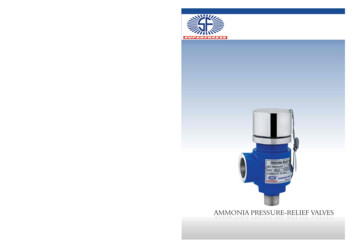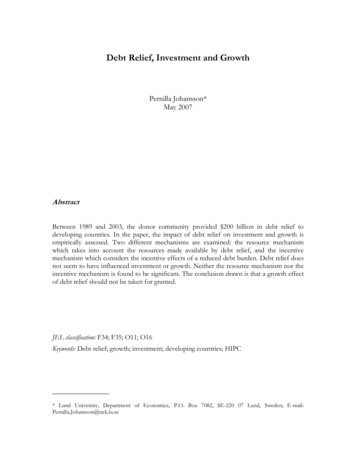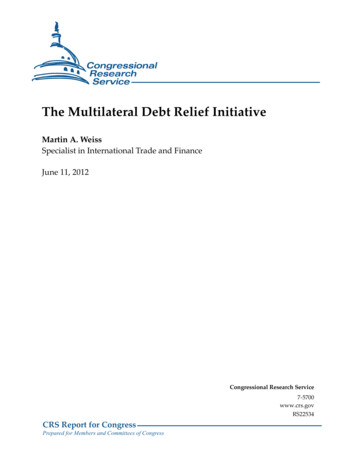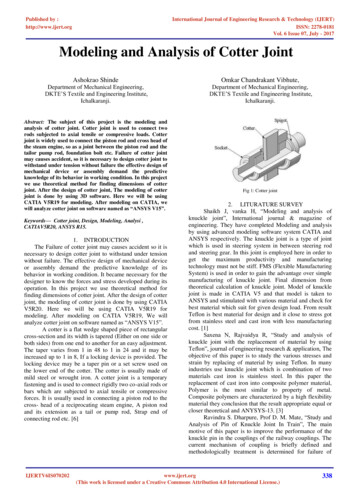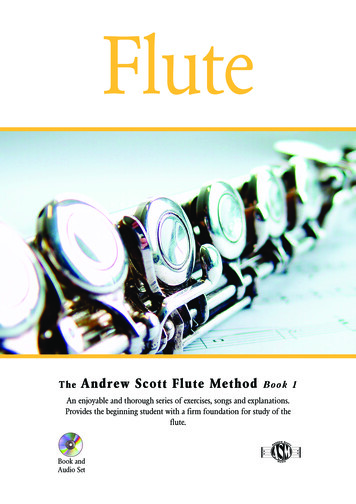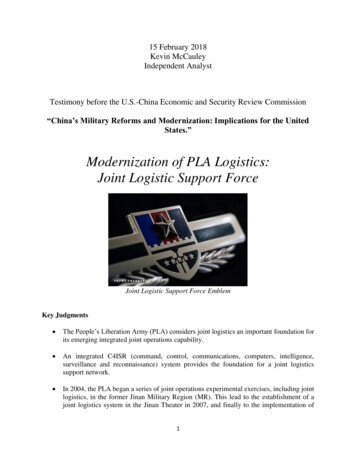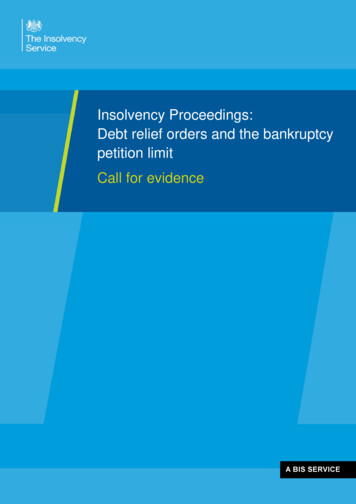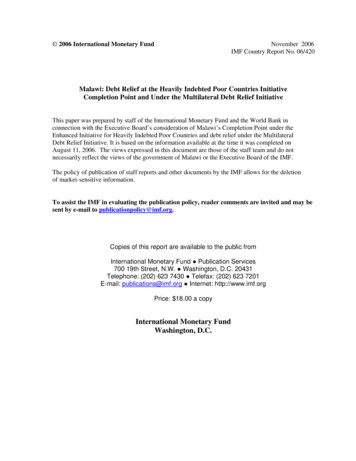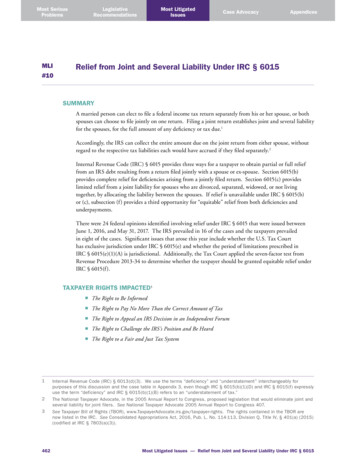
Transcription
Most SeriousProblemsLegislativeRecommendationsMLI ReliefMost LitigatedIssuesCase AdvocacyAppendicesfrom Joint and Several Liability Under IRC § 6015#10SUMMARYA married person can elect to file a federal income tax return separately from his or her spouse, or bothspouses can choose to file jointly on one return. Filing a joint return establishes joint and several liabilityfor the spouses, for the full amount of any deficiency or tax due.1Accordingly, the IRS can collect the entire amount due on the joint return from either spouse, withoutregard to the respective tax liabilities each would have accrued if they filed separately.2Internal Revenue Code (IRC) § 6015 provides three ways for a taxpayer to obtain partial or full relieffrom an IRS debt resulting from a return filed jointly with a spouse or ex-spouse. Section 6015(b)provides complete relief for deficiencies arising from a jointly filed return. Section 6015(c) provideslimited relief from a joint liability for spouses who are divorced, separated, widowed, or not livingtogether, by allocating the liability between the spouses. If relief is unavailable under IRC § 6015(b)or (c), subsection (f) provides a third opportunity for “equitable” relief from both deficiencies andunderpayments.There were 24 federal opinions identified involving relief under IRC § 6015 that were issued betweenJune 1, 2016, and May 31, 2017. The IRS prevailed in 16 of the cases and the taxpayers prevailedin eight of the cases. Significant issues that arose this year include whether the U.S. Tax Courthas exclusive jurisdiction under IRC § 6015(e) and whether the period of limitations prescribed inIRC § 6015(e)(1)(A) is jurisdictional. Additionally, the Tax Court applied the seven-factor test fromRevenue Procedure 2013-34 to determine whether the taxpayer should be granted equitable relief underIRC § 6015(f).TAXPAYER RIGHTS IMPACTED3123462 The Right to Be Informed The Right to Pay No More Than the Correct Amount of Tax The Right to Appeal an IRS Decision in an Independent Forum The Right to Challenge the IRS’s Position and Be Heard The Right to a Fair and Just Tax SystemInternal Revenue Code (IRC) § 6013(d)(3). We use the terms “deficiency” and “understatement” interchangeably forpurposes of this discussion and the case table in Appendix 3, even though IRC § 6015(b)(1)(D) and IRC § 6015(f) expresslyuse the term “deficiency” and IRC § 6015(b)(1)(B) refers to an “understatement of tax.”The National Taxpayer Advocate, in the 2005 Annual Report to Congress, proposed legislation that would eliminate joint andseveral liability for joint filers. See National Taxpayer Advocate 2005 Annual Report to Congress 407.See Taxpayer Bill of Rights (TBOR), www.TaxpayerAdvocate.irs.gov/taxpayer-rights. The rights contained in the TBOR arenow listed in the IRC. See Consolidated Appropriations Act, 2016, Pub. L. No. 114-113, Division Q, Title IV, § 401(a) (2015)(codified at IRC § 7803(a)(3)).Most Litigated Issues — Relief from Joint and Several Liability Under IRC § 6015
AppendicesCase AdvocacyMost LitigatedIssuesLegislativeRecommendationsMost SeriousProblemsPRESENT LAWInnocent Spouse Relief Applicable to All Joint Filers Under IRC § 6015(b)IRC § 6015(b) provides that a requesting spouse shall be partially or fully relieved from joint and severalliability, pursuant to procedures established by the Secretary, if the requesting spouse can demonstratethat:1. A joint return was filed;2. There was an understatement of tax attributable to erroneous items of the nonrequesting spouse; 43. Upon signing the return, the requesting spouse did not know or have reason to know of theunderstatement;4. Taking into account all the facts and circumstances, it is inequitable to hold the requesting spouseliable; and5. The requesting spouse elected relief within two years after the IRS began collection activitiesagainst him or her.5A requesting spouse is eligible for a refund under subsection (b) provided the requesting spouse made thepayment and the requirements of IRC § 6511 have been met.6Allocation of Liability Between Spouses Under IRC § 6015(c)IRC § 6015(c) provides that the requesting spouse shall be relieved from liability for deficienciesallocable to the nonrequesting spouse, pursuant to procedures established by the Secretary. To obtainrelief under this section, the requesting spouse must demonstrate that:1. A joint return was filed;2. At the time relief was elected, the joint filers were unmarried, legally separated, widowed, or hadnot lived in the same household for the 12 months immediately preceding the election; and3. The election was made within two years after the IRS began collection activities against therequesting spouse.Relief under IRC § 6015(c) allocates to each joint filer their respective portion of the deficiency, ascalculated under the allocation provisions of IRC § 6015(d). Regardless of how the deficiency iscalculated under IRC § 6015(d), IRC § 6015(c) does not provide an opportunity for either of the jointfilers to obtain a credit or a refund, only to avoid liability.7 A taxpayer is ineligible for relief underIRC § 6015(c) if the IRS demonstrates that, at the time he or she signed the return, the taxpayer4567An erroneous item is any income, deduction, credit, or basis that is omitted from or incorrectly reported on the joint return.See Treas. Reg. § 1.6015-1(h)(4).Not all actions that involve collection will trigger the two-year period of limitations. Under the regulations, only the followingfour events constitute “collection activity” that will start the two-year period: (1) an IRC § 6330 notice; (2) an offset of anoverpayment of the requesting spouse against the joint income tax liability under IRC § 6402; (3) the filing of a suit bythe United States against the requesting spouse for the collection of the joint tax liability; and (4) the filing of a claim bythe United States to collect the joint tax liability in a court proceeding in which the requesting spouse is a party or whichinvolves property of the requesting spouse. Treas. Reg. § 1.6015-5(b)(2).IRC § 6015(g)(1). Generally, a taxpayer must request a refund within three years from the date his or her return was filed,or two years from the time the tax was paid, whichever occurs later, or, if no return was filed, within two years from the timethe tax was paid. IRC § 6511(a).IRC § 6015(g)(3).Taxpayer Advocate Service — 2017 Annual Report to Congress — Volume One463
Most SeriousProblemsLegislativeRecommendationsMost LitigatedIssuesCase AdvocacyAppendicesrequesting relief had “actual knowledge” of any item giving rise to the deficiency.8 Relief is alsounavailable for amounts attributable to fraud, fraudulent schemes, or certain transfers of disqualifiedassets.9Equitable Relief Under IRC § 6015(f)IRC § 6015(f) provides that the Secretary may relieve a taxpayer from liability for both deficiencies andunderpayments10 where the taxpayer demonstrates that:1. Relief under IRC § 6015(b) or (c) is unavailable; and2. Taking into account all the facts and circumstances, it would be inequitable to hold the taxpayerliable for the underpayment or deficiency.To obtain complete relief under IRC § 6015(b) or allocation under subsection (c) a person must makethe request within two years of the beginning of IRS collection actions against that person.11 IRSconsiders requests for equitable relief under IRC § 6015(f) without regard to when the first collectionactivity was taken.12Prior to July 2011, the IRS interpreted § 6015(f) to impose a two-year time limit on requests forequitable relief.13 In 2009, the Tax Court, in Lantz v. Commissioner, held the regulation imposing thetwo-year limit invalid.14 The IRS appealed Lantz and similar decisions, and three courts of appealsoverturned the Tax Court and upheld the validity of the two-year limit.15 This created an unusualsituation where the Tax Court ruled in accordance with its reasoning in Lantz, where permitted, andruled in accordance with the courts of appeals’ rulings where bound to do so.16 The National TaxpayerAdvocate consistently advocated for removal of the two-year rule that prevented taxpayers fromobtaining equitable relief.17 In July 2011, the IRS changed its position and now considers requests for891011121314151617464IRC § 6015(c)(3)(C).IRC § 6015(c)(4), (d)(3)(C).An underpayment of tax occurs when the tax is properly shown on the return but is not paid. Washington v. Comm’r, 120 T.C.137, 158-59 (2003).IRC § 6015(b)(1)(E), (c)(3)(B).Notice 2011-70, 2011-2 C.B. 135 (July 25, 2011), http://www.irs.gov/pub/irs-drop/n-11-70.pdf. The change in positionapplies to requests submitted after July 25, 2011.Treas. Reg. § 1.6015-5(b)(1).132 T.C. 131 (2009).Manella v. Comm’r, 631 F.3d 115 (3d Cir. 2011), rev’g and remanding 132 T.C. 196 (2009); Jones v. Comm’r, 642 F.3d 459(4th Cir. 2011), rev’g and remanding T.C. Docket No. 17359-08 (May 28, 2010); Lantz v. Comm’r, 607 F.3d 479 (7th Cir.2010), rev’g and remanding 132 T.C. 131 (2009).Adhering to the rule in Goldsen v. Comm’r, 54 T.C. 742, 757 (1970), aff’d, 445 F.2d 985 (10th Cir. 1971), that the Tax Courtwill defer to a Court of Appeals decision which is squarely on point where appeal from the Tax Court decision lies to thatCourt of Appeal, the Tax Court continued to hold the regulation invalid in cases appealable to other circuits. See, e.g., Youngv. Comm’r, T.C. Docket No. 12718-09 (May 12, 2011); Pullins v. Comm’r, 136 T.C. 432 (2011); Stephenson v. Comm’r, T.C.Memo. 2011-16; Hall v. Comm’r, 135 T.C. 374, appeal dismissed (6th Cir. Aug. 2, 2011); Buckner v. Comm’r, T.C. Docket No.12153-09, appeal dismissed (6th Cir. July 27, 2011); Carlile v. Comm’r, T.C. Docket No. 11567-09, appeal dismissed (9th Cir.Dec. 8, 2010); Payne v. Comm’r, T.C. Docket No. 10768-09, appeal dismissed (9th Cir. July 25, 2011); Coulter v. Comm’r, T.C.Docket No. 1003-09, appeal dismissed (2d Cir. Aug. 4, 2011).National Taxpayer Advocate 2010 Annual Report to Congress 377 (Legislative Recommendation: Allow Taxpayers toRequest Equitable Relief Under Internal Revenue Code Section 6015(f) or 66(c) at Any Time Before Expiration of the Period ofLimitations on Collection and to Raise Innocent Spouse Relief as a Defense in Collection Actions); vol. 2, 1-12 (Unlimit InnocentSpouse Equitable Relief); National Taxpayer Advocate 2006 Annual Report to Congress 540 (Legislative Recommendation:Eliminate the Two-Year Limitation Period for Taxpayers Seeking Equitable Relief under IRC § 6015 or 66).Most Litigated Issues — Relief from Joint and Several Liability Under IRC § 6015
AppendicesCase AdvocacyMost LitigatedIssuesLegislativeRecommendationsMost SeriousProblemsequitable relief under IRC § 6015(f) without regard to when the first collection activity was taken.18 TheIRS proposed regulations to codify the change in the two-year rule on August 13, 2013.19 Taxpayers arenow able to file requests for equitable relief within the period of limitation on collection in IRC § 650220or, for any credit or refund of tax, within the period of limitation in IRC § 6511.21Factors Guiding IRS Discretion in Equitable Relief CasesRevenue Procedure 2013-34 provides a nonexclusive list of factors that the IRS considers whendetermining whether equitable relief is appropriate.22 Factors include: Marital status; Economic hardship; Knowledge or reason to know of the understatement or underpayment, including abuse by thenonrequesting spouse; Legal obligation to pay the outstanding tax liability; Significant benefit from the understatement or underpayment; Good-faith effort to comply with income tax laws; and Mental or physical health.23Rights of the Nonrequesting SpouseIn matters where a claim for relief is made under IRC § 6015, the parties who filed the joint return aregenerally referred to as the requesting spouse and the “nonrequesting spouse,” respectively. IRC § 6015provides that the nonrequesting spouse must be notified and given an opportunity to participate in anyadministrative proceedings concerning a claim under IRC § 6015.24 If full or partial relief is grantedto the requesting spouse, the nonrequesting spouse can file a protest and receive an administrative18192021222324Notice 2011-70, 2011-2 C.B. 135 (July 25, 2011), http://www.irs.gov/pub/irs-drop/n-11-70.pdf. The notice providestransitional rules and applies to requests submitted on or after July 25, 2011. The notice also states that pending litigationwill be managed consistently with the removal of the two-year rule. See also CC-Notice 2011-017 (July 25, 2011) (providingdirection for Chief Counsel attorneys handling cases docketed with the Tax Court that involve the two-year deadline).Notice 2011-70, 2011-2 C.B. 135 (July 25, 2011), http://www.irs.gov/pub/irs-drop/n-11-70.pdf. The change in positionapplies to requests submitted after July 25, 2011. A notice of proposed rulemaking removing the two-year rule waspublished in the Federal Register (78 Fed. Reg. 49242) on Aug. 13, 2013, and the IRS adopted guidance implementingremoval of the two-year rule on Sept. 13, 2013. See Rev. Proc. 2013-34, 2013-43 I.R.B. 397. As of the date of this report,the IRS has not promulgated a final regulation.The statutory period of limitations on collection is generally ten years after the date the tax is assessed. IRC § 6502(a).However, a variety of statutory provisions may extend or suspend the collection period. For example, if a court proceedingto collect the tax is brought, such as a suit to reduce a tax liability to judgment, the period of limitations on collection isextended. Therefore, the period of limitations on collection could exceed ten years, and a claim for innocent spouse reliefwould be valid at any point during that time.Generally, taxpayers must request a refund within three years from the date their return was filed, or two years fromthe time the tax was paid, whichever occurs later, or, if no return was filed, within two years from the time the tax waspaid. IRC § 6511(a). If taxpayers meet the three-year requirement, they can recover payments made during the threeyear period that precedes the date of the refund request, plus the period of any extension of time for filing the return.However, taxpayers who do not meet the three-year requirement can recover only payments made during the two-yearperiod preceding the date of the refund request. IRC § 6511(b)(2). Senator Cardin and Representative Becerra introducedcompanion bills that include the National Taxpayer Advocate’s recommendation to codify the removal of the two-year rulethat prevented taxpayers from obtaining equitable relief. S. 2333, 114th Cong. (2015) and H.R. 4128, 114th Cong. (2015).Rev. Proc. 2013-34, 2013-43 I.R.B. 397. Rev. Proc. 2013-34 superseded Rev. Proc. 2003-61, 2003-2 C.B. 296.Id. at 400-03.IRC § 6015(h)(2).Taxpayer Advocate Service — 2017 Annual Report to Congress — Volume One465
Most SeriousProblemsLegislativeRecommendationsMost LitigatedIssuesCase AdvocacyAppendicesconference in the IRS Appeals function.25 The nonrequesting spouse may not petition the Tax Court toappeal the IRS’s administrative determination regarding IRC § 6015 relief.26 However, the requestingspouse may petition the Tax Court for review of the IRS’s administrative determination regardingIRC § 6015 relief, and in those situations, the nonrequesting spouse must receive notice of the TaxCourt proceeding and has an unconditional right to intervene in the proceeding to dispute or supportthe requesting spouse’s claim for relief.27 An intervening spouse has no standing to appeal the TaxCourt’s decision to the United States Courts of Appeals.28Judicial ReviewTaxpayers seeking relief under IRC § 6015 generally file Form 8857, Request for Innocent Spouse Relief.29After reviewing the request, the IRS issues a final notice of determination granting or denying reliefin whole or in part. The taxpayer has 90 days from the date the IRS mails the notice to file a petitionwith the Tax Court.30 The Tax Relief and Health Care Act of 2006 amended IRC § 6015(e) toexpressly provide that the Tax Court has jurisdiction in “stand alone” cases to review IRC § 6015(f)determinations, even where no deficiency has been asserted.31ANALYSIS OF LITIGATED CASESThere were 24 opinions issued between June 1, 2016, and May 31, 2017. The Tax Court issued themajority of the opinions (21 opinions, or 88 percent). The IRS prevailed in full in 16 cases (67 percent)and the requesting spouse prevailed in eight cases (33 percent). Taxpayers had representation in ninecases (37.5 percent), and appeared pro se (i.e., they represented themselves) in the remaining 15 cases(62.5 percent). Pro se taxpayers prevailed in full in five cases (one-third). The nonrequesting spouseintervened in nine cases (38 percent). In cases where the nonrequesting spouse intervened, the IRSprevailed in six cases (67 percent), and the requesting taxpayer prevailed in three cases (33 percent).25262728293031466Rev. Proc. 2003-19, 2003-5 C.B. 371.Maier v. Comm’r, 119 T.C. 267 (2002), aff’d, 360 F.3d 361 (2d Cir. 2004) (holding that there are no provisions inIRC § 6015 that allow the nonrequesting spouse to petition the Tax Court from a notice of determination).Van Arsdalen v. Comm’r, 123 T.C. 135 (2004).Baranowicz v. Comm’r, 432 F.3d 972 (9th Cir. 2005).See IRS Form 8857, Request for Innocent Spouse Relief, Instructions (Sept. 2010).IRC § 6015(e)(1)(A)(ii). Several courts of appeal have held that the ninety-day deadline in § 6015(e)(1)(A) is a jurisdictionalrequirement and the Tax Court lacks jurisdiction to hear untimely petitions for innocent spouse relief, regardless of whetherequitable considerations supporting the extension of the prescribed time period exist. See Matuszak v. Comm’r, 862 F.3d192 (2d Cir. 2017); Rubel v. Comm’r, 856 F.3d 301 (3d Cir. 2017), aff’g No. 16-9183 (T.C. July 11, 2016); Calvo v. Comm’r,117 A.F.T.R.2d (RIA) 2246 (D.C. Cir. 2017). See also Legislative Recommendation: Make Time Limits for Petitioning Tax Courtand Bringing Suit in Other Federal Courts Subject to the Judicial Doctrines of Forfeiture, Waiver, Estoppel, and Equitable Tolling,and Clarify that Dismissal of an Untimely Petition Filed in Response to a Statutory Notice of Deficiency is Not a Decision onthe Merits, infra. The Tax Court recently discussed whether 6015(e)(1)(A) is jurisdictional in Vu v. Comm’r, T.C. Summ. Op.2016-75, and Nauflett v. Comm’r, No. 17-1986 (T.C. Aug. 9, 2016) (Order of Dismissal for Lack of Jurisdiction).Pub. L. No. 109-432, Div. C, § 408(a), (c), 120 Stat. 2922, 3061-62 (2006). Prior to amendment, IRC § 6015(e) providedfor Tax Court review of determinations under IRC 6015(b) or (c), but it was not clear that the Tax Court had jurisdiction toreview requests for relief made only under IRC § 6015(f) when no deficiency had been asserted. The 2006 amendmentfollowed the National Taxpayer Advocate’s recommendation that IRC § 6015(e) be amended to clarify that taxpayers havethe right to petition the Tax Court for review of determinations made only under IRC § 6015(f). See National TaxpayerAdvocate 2001 Annual Report to Congress 159-65 (Key Legislative Recommendation: Joint and Several Liability FinalDetermination Rights). The filing of a Tax Court petition in response to the final notice of determination or after theIRC § 6015 claim is pending for six months is often referred to as a “stand alone” proceeding, because jurisdiction ispredicated on IRC § 6015(e) and not deficiency jurisdiction under IRC § 6213.Most Litigated Issues — Relief from Joint and Several Liability Under IRC § 6015
AppendicesCase AdvocacyMost LitigatedIssuesLegislativeRecommendationsMost SeriousProblemsProcedural IssuesOf the 24 cases identified, five involved procedural issues. In several cases, whether the court hadjurisdiction over petitions for equitable relief filed under section 6015 was at issue. Depending on theforum where the issue is litigated, the interests of the IRS may be represented by the Department ofJustice (DOJ), Tax Division, or the IRS Office of Chief Counsel. The IRS Office of Chief Counselgenerally represents the Commissioner of Internal Revenue in Tax Court litigation.32 The DOJ isresponsible for conducting all federal tax litigation in the federal bankruptcy, district, and appellatecourts, and in state courts.33 This dual representation sometimes creates inconsistent positions takenin litigation. The DOJ successfully argued against allowing taxpayers to raise IRC § 6015 relief asan affirmative defense in refund, collection and some bankruptcy cases, which is inconsistent withthe IRS Office of Chief Counsel’s position.34 The Bankruptcy Court in In re Pendergraft determinedwhether the court’s subject matter jurisdiction extended to innocent spouse relief requests underIRC § 6015.35 The taxpayer petitioned the Bankruptcy Court to determine the validity of the IRS’slien on her homestead, and requested section 6015 innocent spouse relief. The IRS (represented byDOJ Tax) challenged the Bankruptcy Court’s subject matter jurisdiction, pointing to the languageof IRC § 6015(e) in support of the position that review was only available in the Tax Court.36 TheBankruptcy Court rejected the IRS’s argument, reading the wording of Section 6015(e) that permitstaxpayers to seek “any other remedy provided by law” as validating the subject matter jurisdiction it hadto determine innocent spouse claims.37 However, the court stopped short of ruling on the innocentspouse claim, interpreting Section 6015(f) as granting initial subject matter jurisdiction to the Secretaryof Treasury. The court ruled that in order for the bankruptcy court to provide review of an innocentspouse claim, the taxpayer must first follow the procedures prescribed in Section 6015(f) and file a Form8857, Request for Innocent Spouse Relief with the IRS and wait until the IRS makes a determination, oruntil six months pass after making the request without the IRS issuing a determination.38In her 2013 Annual Report to Congress, the National Taxpayer Advocate stated that nothing in thelanguage of IRC § 6015 gives the Tax Court exclusive jurisdiction to determine innocent spouseclaims.39 Instead, the language of IRC § 6015(e) permits a taxpayer to petition the Tax Court forrelief “in addition to any other remedy provided by law.”40 The view taken by the bankruptcy court in323334353637383940Attorneys from the IRS Office of the Chief Counsel also may be appointed as Special Assistant United States Attorneys(SAUSAs) to handle certain tax-related bankruptcy litigation.See 28 C.F.R. § 0.70.See, e.g., U.S. v. Elman, 110 A.F.T.R.2d (RIA) 6993 (2012); U.S. v. Boynton, 99 A.F.T.R.2d (RIA) 920 (2007); U.S. v. Feda,97 A.F.T.R.2d 1985 (2006); In re Mikels, 524 B.R. 805, 807 (Bankr. S.D. Ind. 2015). However, the IRS Office of ChiefCounsel supports permitting taxpayers to raise a IRC § 6015 claim in those contexts, and there has been a long-standingdisagreement on this point between the DOJ Tax Division and the IRS Office of Chief Counsel.In re Pendergraft, 119 A.F.T.R.2d (RIA) 1229 (Bankr. S.D. Tex. 2017).Id. The IRS cited to multiple cases in support of its argument that the Tax Court has exclusive jurisdiction over innocentspouse claims. See, e.g., U.S. v. LeBeau, 109 AFTR 2d (RIA) 1369 (S.D. Cal. 2012) (district court jurisdiction to decide aninnocent spouse issue only exists when the taxpayer files a refund suit while an innocent spouse petition is pending withthe Tax Court); U.S. v. Boynton, 99 AFTR 2d (RIA) 2007 (S.D. Cal. 2007) (“It is difficult to believe that Congress would havecreated a situation fraught with possibilities for inconsistent judgments and contrary to basic principles of judicial economywith the phrase, ‘[i]n addition to any other remedy provided by law.’”); In re French, 86 AFTR 2d (RIA) (Bankr. N.D. Ohio2000) (bankruptcy court to be an improper forum for innocent spouse determinations).In re Pendergraft, 119 A.F.T.R.2d (RIA) 1229 (Bankr. S.D. Tex. 2017). This is consistent with the National TaxpayerAdvocate’s position that nothing in the language of IRC § 6015 confers exclusive jurisdiction on the Tax Court for innocentspouse claims. See National Taxpayer Advocate 2013 Annual Report to Congress 408-19.In re Pendergraft, 119 A.F.T.R.2d (RIA) 1229 (Bankr. S.D. Tex. 2017).National Taxpayer Advocate 2013 Annual Report to Congress 408-19.IRC § 6015(e).Taxpayer Advocate Service — 2017 Annual Report to Congress — Volume One467
Most SeriousProblemsLegislativeRecommendationsMost LitigatedIssuesCase AdvocacyAppendicesthis case is consistent with the National Taxpayer Advocate’s longstanding position detailed in severallegislative recommendations she made to clarify this issue.41The Court of Appeals for the Third Circuit in Rubel v. Commissioner42 also interpreted the language ofIRC § 6015(e) to determine whether the Tax Court had jurisdiction to review an IRS determinationdenying innocent spouse relief if the petition was filed after the ninety-day deadline prescribed byIRC § 6015(e)(1)(A). After the taxpayer missed the window statutorily prescribed for seeking Tax Courtreview of the IRS’s unfavorable determination of her request for innocent spouse relief, the taxpayerpetitioned the court to consider her claim on equitable grounds. The Court of Appeals for the ThirdCircuit recognized the Tax Court’s jurisdiction in a plain language reading of the statute, but unless theIRS has failed to issue a notice a determination, the Tax Court’s jurisdiction does not extend to petitionsfiled outside the 90-day timeframe regardless of equitable considerations supporting the extension of theprescribed time period. The Court of Appeals upheld the Tax Court’s decision to dismiss the case.43Relief on the MeritsNineteen cases were decided on the merits and taxpayers received full relief in eight of thosecases. Whether the spouse requesting relief had knowledge that there was a deficiency or that thenonrequesting spouse would not pay the tax owed on the return was a factor in 16 of the 19 decisions,including seven of the eight decisions where taxpayers received full relief.44 In eight of the 19 cases, thenonrequesting spouse intervened to oppose relief. Of these eight cases, the IRS prevailed in five cases,and the requesting spouse prevailed in three.In Okorog v. Commissioner, the taxpayer claimed she was a victim of significant spousal abuse, and thather husband tightly controlled all aspects of finance within their marriage.45 She sought relief from ajoint liability under the innocent spouse provisions of IRC § 6015(f).46 The taxpayer claimed that herhusband routinely kept her in the dark regarding financial matters and did not allow her to review anytax return documents prior to filing.47 She asserted that she did not recall ever signing a tax return. Thetaxpayer’s husband intervened to oppose her claim for innocent spouse relief, and disputed the validity ofthe returns.484142434445464748468The National Taxpayer Advocate has recommended that Congress address this issue in three Annual Reports to Congress.National Taxpayer Advocate 2010 Annual Report to Congress 377 (Legislative Recommendation: Allow Taxpayers toRequest Equitable Relief Under Internal Revenue Code Section 6015(f) or 66(c) at Any Time Before Expiration of the Period ofLimitations on Collection and to Raise Innocent Spouse Relief as a Defense in Collection Actions); National Taxpayer Advocate2009 Annual Report to Congress 378 (Legislative Recommendation: Allow Taxpayers to Raise Relief Under Internal RevenueCode Sections 6015 and 66 as a Defense in Collection Actions); National Taxpayer Advocate 2007 Annual Report to Congress549 (Legislative Recommendation: Allow Taxpayers to Raise Relief Under Internal Revenue Code Sections 6015 and 66 as aDefense in Collection Actions).Rubel v. Comm’r, 856 F.3d 301 (3d Cir. 2017), aff’g No. 16-9183 (T.C. July 11, 2016).On July 5, 2017, which is outside of the reporting period for this annual report, the Circuit Court of Appeals for the SecondCircuit reached the identical conclusion that the period of limitations in IRC § 6015(e)(1)(A) is jurisdictional and cited Rubel.See Matuszak v. Comm’r, 862 F.3d 192 (2d Cir. 2017).All three methods of relief under IRC § 6015 contain a knowledge element. Knowledge may be actual or constructive, andthe absence of knowledge weighs in favor of relief. See IRC §§ 6015(b)(1)(C), 6015(c)(3)(C); Rev. Proc. 2003-61, 2003-2C.B. 296 §§ 4.02(1)(b) and 4.03(2)(a)(iii); see also Notice 2012-8, §§ 4.02(3) and 4.03(2)(c), 2012-4 C.B. 309.Okorogu v. Comm’r, T.C. Memo. 2017-53.Id.Id.Id.Most Litigated Issues — Relief from Joint and Several Liability Under IRC § 6015
AppendicesCase AdvocacyMost LitigatedIssuesLegislativeRecommendationsMost SeriousProblemsThe court in Okorog applied the “tacit consent rule” to determine by inference whether the taxpayer hadacquiesced to the validity of the joint returns her husband filed, despite the fact that she may have failedto sign the return.49 The court described the tacit consent rule to be “an extension of the presumptionof correctness that generally attaches to the Commissioner’s determinations .”50 The court foundthat although the taxpayer had no knowledge of the validity of the returns, she nonetheless tacitlyconsented.51 However, the taxpayer established that she suffered from constant emotional and physicalabuse. The court ruled that her husband’s opposition was simply vindictive and granted her claim forinnocent spouse relief.52In Canty v. Commissioner, the taxpayer sought relief from joint and several liability for deficiencies,penalties, and interest arising from tax returns she filed jointly with her husband in 2010 and 2011.During 2010 and 2011, the taxpayer’s husband was self-employed in a solo law practice, and he preparedand filed a Schedule C with their joint return that erroneously reported several items related to theaccounting of his law practice. Beginning i
purposes of this discussion and the case table in Appendix 3, even though IRC § 6015(b)(1)(D) and IRC § 6015(f) expressly . use the term "deficiency" and IRC § 6015(b)(1)(B) refers to an "understatement of tax." 2. The National Taxpayer Advocate, in the 2005 Annual Report to Congress, proposed legislation that would eliminate joint and
